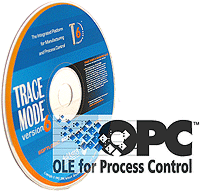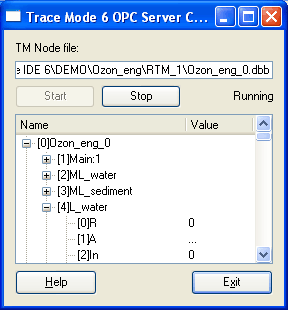TRACE MODE 6 and T-FACTORY 6 fully support the OPC technologies (client and server).
 OPC (OLE for Process Control) is an open international standard for program interface ensuring connectivity of industrial software and devises. The OPC support helps users to link software products made by different independent manufactures, who never tested their interoperability. The growing OPC use, has resulted in publishing of many OPC specifications and versions having different and often excessive features. The OPC standard specifies its own alarms and events, historical data access, security and so on. However, among all specifications the most widely used is OPC Data Access (OPCDA), which is used to move real-time data from PLCs, DCSs, and other control devices to HMIs and other display clients. The OPCDA specification is fully supported in the TRACE MODE HMI. OPC (OLE for Process Control) is an open international standard for program interface ensuring connectivity of industrial software and devises. The OPC support helps users to link software products made by different independent manufactures, who never tested their interoperability. The growing OPC use, has resulted in publishing of many OPC specifications and versions having different and often excessive features. The OPC standard specifies its own alarms and events, historical data access, security and so on. However, among all specifications the most widely used is OPC Data Access (OPCDA), which is used to move real-time data from PLCs, DCSs, and other control devices to HMIs and other display clients. The OPCDA specification is fully supported in the TRACE MODE HMI.
The OPC specify interaction of two program modules: OPC server and OPC client. An OPC example is a program that acquires data from a PLC via its communication protocol and transmit them through OPC server protocol to other software application that supports an OPC client interface (e.g. HMI). In this case the OPC server is a gateway through PLC and HMI software.
 The OPC client is built-in by default to all TRACE MODE 6 and T-FACTORY 6 servers - Real Time Monitors (RTM, RTM+ etc). The OPC client is built-in by default to all TRACE MODE 6 and T-FACTORY 6 servers - Real Time Monitors (RTM, RTM+ etc).
The use of this gateway has its own advantages and disadvantages as compared to drivers embedded in HMI. The main advantage of the OPC is openness. If a PLC is provided with an OPC server it will be compatible with TRACE MODE HMI, even though this PLC is not included in the I/O driver list. But there are also some disadvantages:
- the cost of OPC server is often close to the HMI runtime cost, while the TRACE MODE built-in drivers are absolutely free-of-charge;
- generally regarded an OPC server is slower than a direct I/O driver, though the driver based HMI are faster;
- an OPC based control system development consumes more engineering time, because not only an HMI data sources should be tuned, but in addition OPC tags should also be configured;
- OPC server consume more system resources, that may be critical for large scale control systems.
That is why if a built-in driver is available for PLC, it is not recommended to use the OPC server.

The TRACE MODE OPC server is an independent software application. The TRACE MODE OPC server enables third party HMIs to access the real time data in controllers run under the Micro TRACE MODE.
The TRACE MODE OPC server may also be used to connect third party software products to the TRACE MODE SCADA/HMI and T-Factory MES/EAM/HRM servers through the following physical interfaces:
- RS 232/485;
- dedicated modem line;
- dial up modem line (phone number);
- TCP/IP network;
- GSM SMS.
The TRACE MODE OPC server supports standard protocols OPCDA 1.0 and 2.0.
In the next future the OPC Historical Data Access (HDA) specification will be also supported in TRACE MODE and T-FACTORY. |










 The OPC client is built-in by default to all TRACE MODE 6 and T-FACTORY 6 servers - Real Time Monitors (RTM, RTM+ etc).
The OPC client is built-in by default to all TRACE MODE 6 and T-FACTORY 6 servers - Real Time Monitors (RTM, RTM+ etc). 





















